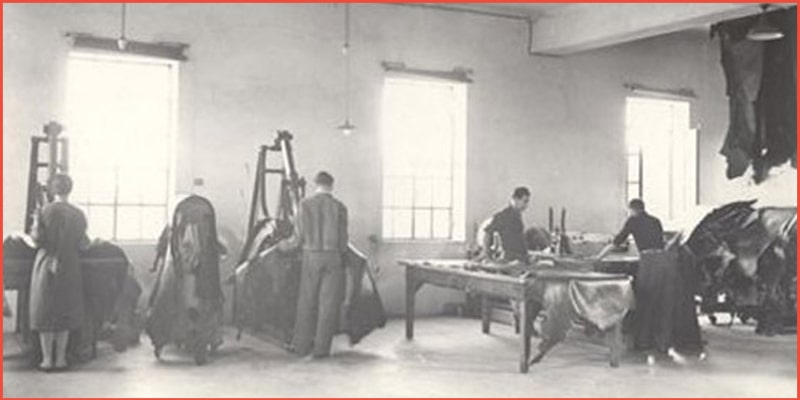Leather has a long and illustrious history. It is one of mankind’s oldest materials, having been used for clothing and tools for thousands of years. To protect their bodies, our ancestors used leather produced from animal hides. Without a question, it has played an important role in the development of civilization and is a magnificent example of resourcefulness.
Leather, on the other hand, has been a vital part of fashion and design for ages and is one of the world’s primitive and most valuable discoveries. Earlier, men hunted wild animals for food, then used their hides to make clothes, footwear, and rudimentary tents. Some aspects of the early leather-making technique, as well as a related craft, are still in use today. Leather indeed has a long history of tying people from all over the world together.
But what is it, exactly? Let’s take a look closer at this excellent material.
What Exactly Is Leather?
Factually people used to wrap their bodies in dried animal pelts, but skin stiffening and rotting were an issue. As a result, they figured out how to soften and preserve the skin. That was the beginning of leather processing, and leather was born. The hides or skins were most likely dried in the open air and in the sun at first. They were then bathed in water and dried over an open flame. However, later on, the method of soaking twigs, barks, and leaving the skin in water developed, which assisted in the preservation of animal skins. Archaeologists reported that primitive man used the skins of hunted animals as a source of food and clothing.
Leather is made mostly from the hide or skin of birds, fishes, mammals and reptiles. The animal skins are then subjected to a tanning process, in which tanning compounds react with the collagen in the skin to render it waterproof, stable, and impervious to deterioration.

Back to the Beginning of Leather’s History:
One of the preliminary human artefacts was leather. Leather processing dates back to the beginning of time. Man sought shelter from the elements in the prehistoric past, but soon discovered that the animals he ate could be utilized not only as food, but also as clothes and houses.
The earliest evidence of leather craftsmanship, including hide scarping, according to academics dates back around 400,000 years. Neanderthals didn’t require clothes back then because their bodies were covered in hair, so the hunters, began collecting the skins of the animals they had just slain in order to use them as sunshades. During hunting seasons, they hung the hides on branches and took them. Because of the alternating rain and sunshine, these skins only survived a short time.
Around 8000BC, an unexpected flood struck, making the season rarer than it had been during the Upper Paleolithic (old stone age). Rain and sunshine grew more often, and the cold became more prevalent, prompting people to wrap themselves in blankets to sleep. As a result of the genetic mutation, they began to lose their thick hair. As a result, their skin began to demand protection. They started hunting more regularly and trying to make their skins last longer.
Around 2200 BC, a shepherd from Sinai butchered his goat, removed the skin, and defatted it with clay and salt, according to the Hittites’ record. Unfortunately, the skin was blown away by a burst of wind. It landed in a rock hollow, which was filled with water containing partially dissolved alum salts. The presence of salt on the skin was favored by the alum in the water, which prevented the skin from degrading. When the shepherd passed by the same rock a month later, he discovered his goat’s hide. Unusual thing was the skin went white but did not decay. He was astounded when he saw it. He picked it up, re-dried it, and wore it.
After seeing the skin’s success, he tried the process again under the identical conditions, but the skin didn’t degrade this time. He noticed that the water in this location had strange qualities and was high in salt, which he dubbed “Rock Salt.” That’s how he became the world’s first tanner. It was then specialized by Hittites, merchants, who sold it via caravans across different locations.
The Hittites were the only ones competent of tanning leather for about 1000 years. It was a feature that contributed significantly to their success. Many historians believe that leatherwork developed by accident. It’s uncertain how long ago vegetable tanning was invented, although it’s said to have happened by accident.

Leather’s Origin in USA:
Historical factors can sometimes drive industries. Early European settlement in North America resulted in the development of leather businesses. Before 1650, tanneries had been built in New England, Virginia, and the Middle Colonies. Throughout the mid-nineteenth century, colonists continued to use European handcraft skills with modest adjustments.
Tanneries rose in number as the population of the United States and the colonies that made it up grew. Until 1850, the most significant developments in the sector were organizational. Emerging regional leather markets prompted the establishment of larger tanneries, the separation of merchants and tanners, and a concentration of tanning in cities with plentiful hides and the Catskill Mountains in New York, where hemlock trees abound. Augustus Schultz, a New York dye salesman, and Martin Dennis, a scientifically trained tanner, created chrome tanning, which substituted chromic acid for tannin and reduced tanning time, based on German innovations.
Later, the mechanized factory eliminated most hand labor in the leather industry during the second half of the nineteenth century. Unhairing, scraping, beating, splitting, tan, drying, and finishing leather machines were invented by tanners and leather-machinery companies. Leather machinery companies disseminated machines and knowledge of machine design, fostering inventiveness.
After WWII, new techniques enhanced tanning machines and procedures, resulting in waterproof, washable, and scuff-resistant leathers, as well as computer-aided design, injection molding, and laser cutting.
Ending Notes:
Today’s leather clothing and accessories market is inspired by previous eras due to a focus on quality and heritage. Whether it’s tough leather boots reminiscent of Western cowboys or vintage aviators that epitomize the WWII decades, fashion designers now draw inspiration from history to build the leather items of tomorrow.
Due of its long history, historical leather fashion styles will always be relevant. Designers who are, always in the search for fresh and inventive ways to use this classic fabric. Regardless of aesthetic or practicality and despite the difficulty of predicting its future trends or fads, leather will always have a big role in modern culture.
Visit huffam.com if you’re interested in learning more about leather.

